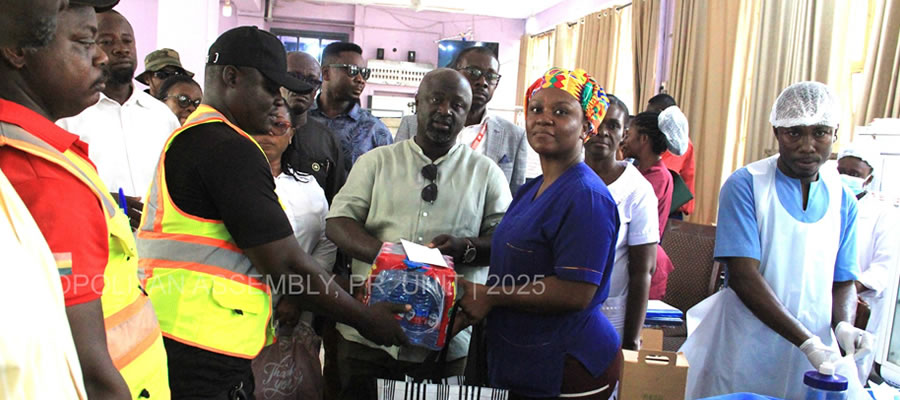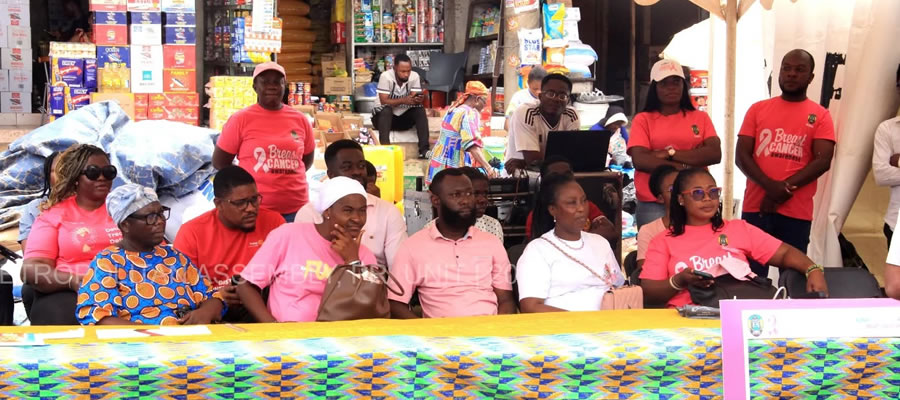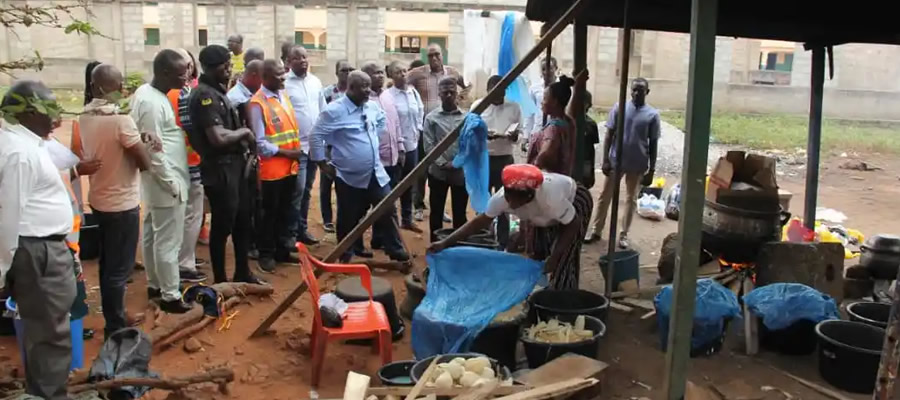

Educational facilities in the city are provided by the public, private (individual and religious bodies) sectors. The private sector provides the bulk of these institutions at the pre-school, first and second cycle levels, whereas the public sector is the leader at teacher training colleges and tertiary levels. These are evenly distributed in space.
Analysis of the educational sector focuses on three main levels. These are pre-School, Basic School – Primary and Junior Secondary Schools; Second Cycle Schools – Senior Secondary Schools, Teacher Training Colleges, Special Education and Vocational/Technical/Commercial Schools.
Pre-School Education
The age range for Pre-School Education is between 4 and 5 years. Data for Pre-School Education in the Metropolis for the years 2003/2004 and 2005/2006 are provided in Tables 17 and 18.
Analysis of Tables 17 and 18 shows that in terms of Pre-School structures the private sector continues to lead. In 2003/2004, the private sector accounted for 459 out of the 607 Pre-School structures representing 75.6%. In 2006, it again provided 478 out of the 633 Pre-school structures representing 75.5%.
In terms of Pre-School Enrollment in 2003/ 2004 the private sector accounted for 26,939 out of the 36,971 total enrollment figures for both sectors, thus representing 72.9%. The same trend was established in 2006. Out of the 58,530 total Pre-School enrollments, the private sector accounted for 41,321 representing 70.6%. However, from 2003/2004 to 2005/2006 the public sector has seen some growth in terms of Pre-school structure provision and enrollment. It increased its infrastructure provision from 148 to 155 representing a growth rate of 4.5% Even though the private sector provision increased from 459 in 2004 to 478 it made some loses in percentage points and fell from 75.6% to 75.5%.
The public sector’s development of pre-school is constrained by the requirement of high and costly standards while the private sector resort to the use of flexible conditions by operating in residential and temporary structures. However, it must be pointed out that some of the structures used by the private sector are substandard.
The same pattern was established in enrollment. Whereas the private sector’s percentage contribution fell from 72.9% in 2003/2004 to 70.6% in 2005/2006, the public sector made some percentage gains from 27.1% in 2003/2004 to 29.4% in 2005/2006. This dramatic increase in enrollment is attributable to the introduction of the Capitation Grant (and the School Feeding Programme in some selected schools).
Tables 19 and 20 shows the number of teachers in Pre-School in the Kumasi Metropolis in the 2003/2004 and 2005/2006 Academic Years.
Analysis of teachers in Pre-School in the 2003/2004 and 2005/2006 academic years indicate there were 1,306 and 1,698 teachers respectively in the system. There was therefore an increase of 392 representing 23%. In 2003/2004 the private sector contributed 980 teachers whilst the public sector contributed 326 to the total number of teachers representing 75% and 25% respectively. In the2005/2006 academic year the private sector’s contribution to the total number of teachers was 1,283 whilst the private sector’s contribution was 415 representing 75.6% and 24.4% respectively. Both tables also reveal that the bulk of trained teachers were in the public sector, whereas the private sector led in the recruitment of untrained teachers.
In 2003/2004 and 2005/2006 the number of trained teachers in the public sector were 313 and 400 representing 67.3% and 71% of the total number of trained teachers in both the public and private sectors. During the periods the private sector’s share of trained teachers was 152 and 162 representing 32.7% and 29% respectively. In terms of untrained teachers the public sector had 13 in 2003/2004 and 15 in 2005/2006 representing 1.5% and 1.3% respectively of the total number of untrained teachers in the metropolis, whereas the private sector had 828 in 2003/2004 and 1,121 in 2005/2006 representing 98.5% and 98.7% respectively.
(a) Participation in Education
The pre-school population of (9% of the population) in the metropolis then was 129,770. This gave a pre-school participation rate of 28.5%. However, Table 15 reveals that in 2005/2006 a total of 58,530 children are currently in pre-school as against the proportion of 144,978 who constitute children of pre-school going age, giving a school participation (current projected population, 1,610,867) rate of 40.4%. Not withstanding the fact that the pre – school participation rose from 28.5% during the 2003/2004 academic year to 40.4% during the 2005/2006 academic year the figure is on the low side. More public education is needed to sensitise parents to send their children to school.
That marginal increase however, calls for an increase in educational infrastructure, as the rate of participation will continue to rise in the face of population growth, capitation grant and the School Feeding Programme.
(b) Classroom and Teacher Requirement at Pre-Schools
Ghana Education Service puts the population of a standard classroom at 40 pupils. Giving that 1,266 classrooms are available for the pre-school population of 50,640, it means that there is a shortfall of 1,179 classrooms for pre-school children in the metropolis. Given the present situation of acute shortage of classrooms there is overcrowding in the existing facilities. The pre-school teacher population of 1,698 gives a teacher/pupil ratio of 1:34, which is quite satisfactory. It is however worrisome that more than two-thirds of the teachers are untrained. (Trained 33.1; Untrained (66.9)
Basic School Education
The Basic School comprises the primary and Junior Secondary levels and the age range is 6 to 15 years. Table 21 and 22 outline the number of basic schools, enrollment levels and number of teachers in the existing schools for the 2003/2004 and 2005/2006 Academic Years. These two scenarios have been presented for comparative analysis.
(c) Participation in Basic Education
Statistics, from the year 2003/2004 academic year show that out of an estimated population of 410,939 that fall within the basic school going age of 6-15 years (given an estimated population of 1,441,890 in the metropolis and the fact that about 28.5% were in this cohort) 227,179 were in school (as shown in Table 23) leaving a number of 183,760 who were not in school. Given that the basic school participation rate was 55.3%. This fell short of the national participation rate of 80% by 24.7%.
Table 24 also shows that there are 341,011 of this age cohort in school in the 2005/2006 academic year. People in this age group constitute about 28.5% of the population in the metropolis. Against the projected population of 1,625,180 in 2005/2006 it is estimated that about 463,176 are in this age group. By this, it is estimated that about 122,165 are not in school giving the basic school participation rate as 73.6% and a non-participation rate of 26.4%. This falls short of the national participation rate of 80% by 6.4%. The upsurge in enrollment figures culminating in an increase in basic school participation rate from 55.3% to 73.3% may be partly accounted for by the introduction of the Capitation Grant and the School Feeding Programme in selected schools.
(d) Provision of Basic School Classrooms
In terms of basic education level infrastructure the private sector provided 633 in 2003/2004 academic year and 662 in 2005/2006 academic year representing 64.5% and 63.6% respectively, whereas the public sector provided 349 and 379 representing 35.5% and 36.4% accordingly.
This reveals that the private sector continues to play a dominant role in infrastructure provision at the basic school level. It is a healthy development except that the fees they charge are quite prohibitive and some of the infrastructure is substandard.
Giving an existing 9,369 classrooms at this level and against the backdrop of a high basic school going age, there is a deficit in basic school infrastructure of 328 classrooms representing roughly 36 single stream schools of Primary and Junior Secondary given that a classroom contains 40 pupils. The deficit in basic school infrastructure has improved from 351 (about 39 single stream schools of Primary and Junior Secondary Schools) in 2003/2004 academic year to 328 in 2005/2006 academic year representing 36 single stream of primary and J. S .S given that a standard classroom takes 40 pupils.
(e) Teacher Requirement at Basic School Level
In 2003/2004 the private sector provided the bulk of Teachers in both Primary and JSS levels. However, in the Primary level in the private sector, Untrained Teachers represent 95.8% of the total number of untrained teachers as against 4.2% by the public sector. At the JSS level a similar trend has been established. In terms of Trained Teachers the public sector has 2,078 as against 312 by the private sector representing 86.9% and 13.1% respectively. In a similar token the private sector has the bulk of Untrained Teachers. The private sector at the primary level has 2876 Untrained Teachers whereas the public sector has 126 untrained teachers representing 95.8% and 4.2% respectively.
At the J.S.S level the public sector continues to provide the bulk of Trained Teachers whilst the private sector leads in Untrained Teachers. The public sector accounts for 2,078 of the total number of trained teachers (2,390) representing 86.9% whilst the private sector accounts for 312 representing 13.1%. In terms of untrained teachers the private sector accounts for 1,197 of the total number 1,250 whilst the public sector has 53 representing 96% and 4% respectively.
In 2005/2006 academic year again, it provided most of the teachers in the system, yet the bulk of them were untrained. Within the period under review the number of teachers in the private sector was 5,183 whilst the public sector 4,216 representing 55.1% and 44.9% respectively.
In terms of trained teachers in the primary division the public sector provided 1,912 whereas the private sector provided 517 representing 78.7% and 21.3% respectively. In terms of untrained teachers, the private sector provided a total of 2,992 whilst the public sector provided 116 thereby representing 96.3% and 3.7% respectively. At the JSS division the public sector provided 2,127 teachers, whereas the private 346 representing 86% and 14% respectively. In terms of untrained teachers the public sector accounted for 61 and the private sector 1,328 representing 4.4% and 95.6% respectively.
The number of teachers in the system grew from 9,041 in the 2003/2004 academic year to 9,401 in the 2005/2006 academic year depicting a growth of 3.8%. In terms of trained teachers in the public sector, the number increased from 3,993 in the 2003/2004 academic year to 4,039 in the 2005/2006 academic year representing a growth of 1.1% whereas that of untrained teachers in the period under review fell from 189 to 177 representing a fall of 6.8%. In the private sector, the number of trained teacher increased from 796 in the 2003/2004 academic year to 863 in the 2005/2006 academic year representing 7.8%. In terms of untrained teachers the number grew from 4,073 in 2003/2004 academic year to 4,320 during the 2005/2006 representing a 5.7 % increase.
In conclusion, the teaching staff situation in the metropolis generally improved from the 2005/2006 academic year over that of the 2003/2004 academic year by 5.7%.
Tertiary Education
The Metropolis has four Tertiary Institutions, namely; Kwame Nkrumah University of Science and Technology (KNUST), University of Education Winneba, Kumasi Campus (UEW-K), Christian University College (private) and the Kumasi Polytechnic.
Key Problems and Opportunities/Potentials
The problems and opportunities identified under the three levels, namely; pre-school, basic and second cycle and tertiary.
(a) Key Problems at the Pre – School Level
Inadequate facilities
Poor qualify structures used by some private operators (This generates a feeling of insecurity in parents to send toddlers to school
Existing Opportunities at Pre-School Level
Among the opportunities/potentials of pre-school level of education in the Metropolis are:
High private sector participation
Large number of teachers
Institution of capitation grant in public schools
(b) Key Problems at the Basic School Level
Inadequate classroom facilities (short fall of 328)
Uneven distribution of facilities e.g. Nsenie, Oduom, Atonsu-Bokuro and Ahinsan Estate have no public schools
High non-participation rate of 25.7% as against a national standard of 20%.
Current Challenges
Inadequate classroom facilities
Large number of untrained staff at pre- school and basic levels.
High school fees especially by the private operators
Encroachment on school lands by developers and squatters
Inadequate logistics for example, Textbooks, means of transport, communication facilities etc.
Low participation rate (59.6% of pre-school children are not in school)
Large number of untrained staff.
High school fees which are beyond the reach of many.
Date Created : 11/28/2017 6:42:32 AM












 facebook
facebook
 twitter
twitter
 Youtube
Youtube
 +233 593 831 280
+233 593 831 280 0800 430 430
0800 430 430 GPS: GE-231-4383
GPS: GE-231-4383 info@ghanadistricts.com
info@ghanadistricts.com Box GP1044, Accra, Ghana
Box GP1044, Accra, Ghana